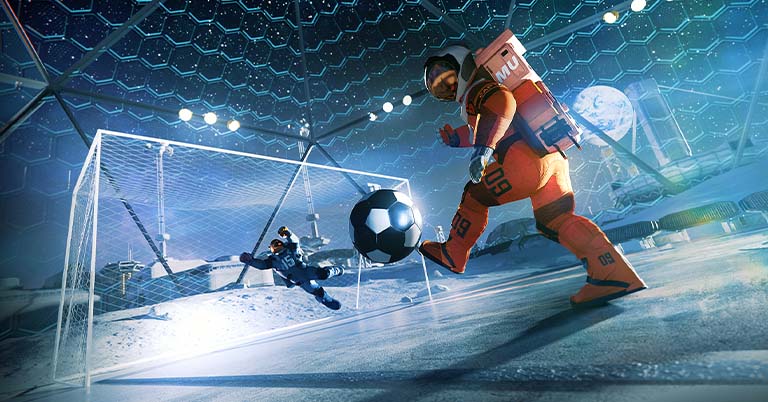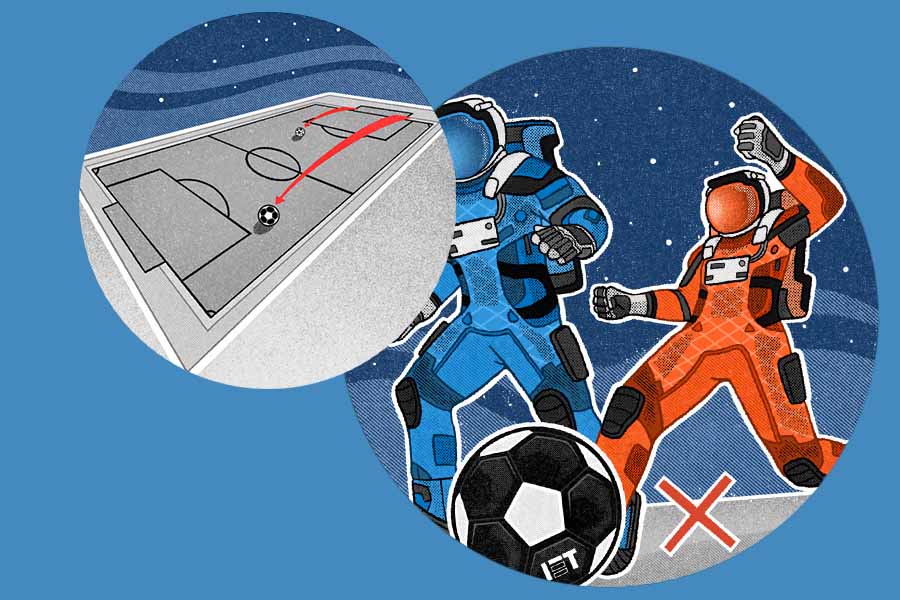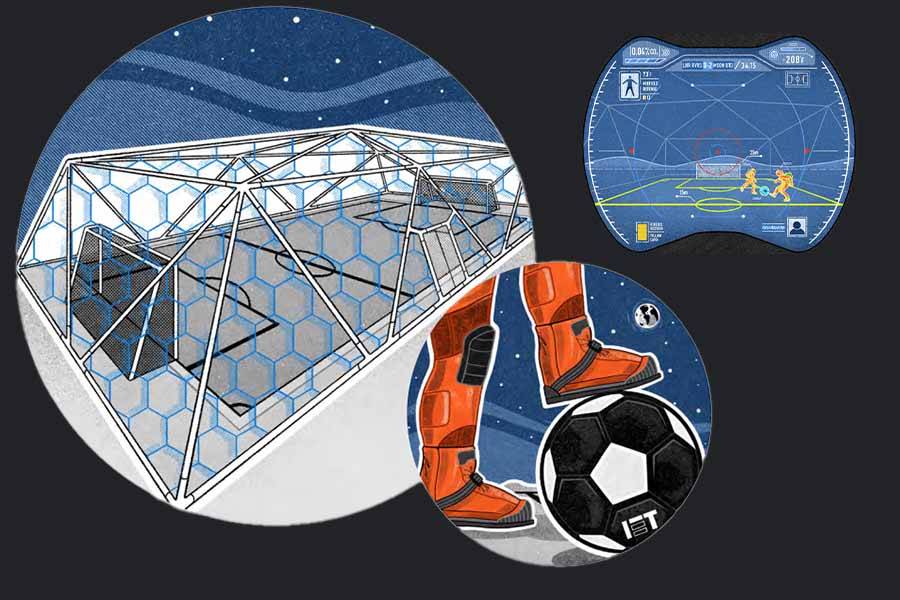
A recent post by the Insitute of Engineering and Technology (IET) UK highlights the possibility of competitive football on the surface of the Moon. That too as soon as 2035! But it’s going to be a LOT different than a football game here on Earth. Let’s take a look at what Football on the Moon could possibly look like in the next decade or so.
Football on the Moon?
A panel of engineers, technologists, and scientists at IET have created the first lunar football rule book that has made a couple of changes to football as we all know and love. To adapt the game to the uninhabitable conditions of the Moon, it will be played very differently.
But how is this possible?
Moon’s gravity is six times weaker than that of the Earth, which means a ball traveling at the same speed will travel six times further there. What about the players’ jerseys? What about the playtime? Fear not as the scientists have thought of all that.

Players must wear a flexible airtight suit with oxygen tanks, heating and cool systems, inbuilt padding, and flannel to absorb sweat. They’ll have “Moon Boots” instead of studded ones. Their helmets will have a built-in visor for communication too, while the match will be refereed by a hologram referee + VAR, which will give virtual yellow and red cards directly to the player’s visors.
Gametime and player count
Lunar football will be a 5-on-5 game with no tackles or headers allowed. So interceptions will be the only way to steal the ball from your opponent. Games will be played on lunar noon for maximum visibility and low shadows. Since a 90-minute game isn’t feasible on the Moon, IET proposes a condensed version with four 10-minute quarters instead. There’ll be a generous 20-minute break between the quarters for refueling and recovery. So although the playtime will be less, a single game of lunar football will last 100 minutes.
Ball, Pitch, and Goal

The game ball will be 1.5x larger and contain a “next-gen aerogel” core. This will make it easier for players to hit and bounce the airless sphere. The pitch itself will have to be laser sintered to ensure a consistent and durable playfield. It’ll be shrunk down to 32m x 25m to prevent exhaustion. For reference, a regulation football ground on Earth measures 105m x 68m, which is about 8 times larger. Goalpost will also be larger (10.9m x 2.92m) to account for the fact that jumping on the Moon is much easier.
But why?
That’s great and all but are you also wondering why do all this? We’re still far far away from commercializing Moon travel and we don’t even have a proper Moon base yet. Then why would anyone care about playing football on the lunar surface, when we have much bigger things to worry about?
Well, the IET has good reasons behind it. Though it seems like a far-fetched dream right now, International Lunar Football might only be a generation away. As such, IET wants children to be encouraged and inspired by a potential future in STEM. So alongside the post, they also launched a competition for kids in the UK (aged 4 – 13) to design the first official “Moon Utd Football Kit” in order to kick off its “Engineer a Better World” initiative.
“Getting young people to think about how engineering and technology can be part of the things that they love is really important, and doing this from an early age is essential in showcasing the opportunities available and raising aspirations for careers in these sectors,” said Ama Frimpong, one of the judges of the competition.
So, although it seems silly to write a rule book for something so far ahead in the future, it can serve as an inspiration for young children to get interested in STEM fields. By coupling the imaginative allure of lunar football with engineering, IET seeks to kindle the curiosity and interest of children to explore and pursue science.
- Meanwhile, check our review of Lenovo Yoga 9i (2023)







![Best Gaming Laptops in Nepal Under Rs. 250,000 (रु 2.5 Lakhs) [2025] Best Gaming Laptops Under 2.5 lakhs in Nepal [Feb 2025 Update]](https://cdn.gadgetbytenepal.com/wp-content/uploads/2025/02/Best-Gaming-Laptops-Under-2.5-lakhs-in-Nepal-Feb-2025-Update.jpg)
![Best Gaming Laptops in Nepal Under Rs. 120,000 (रु 1.2 Lakhs) [2025] Best Budget Gaming Laptops Under Rs 120000 in Nepal 2025 Update](https://cdn.gadgetbytenepal.com/wp-content/uploads/2025/05/Best-Budget-Gaming-Laptops-Under-Rs-120000-in-Nepal-2024-Update.jpg)
![Best Laptops Under Rs. 80,000 in Nepal [2025] Best Laptops Under 80,000 in Nepal March 2025 Update](https://cdn.gadgetbytenepal.com/wp-content/uploads/2025/03/Best-Laptops-Under-80000-in-Nepal-March-2025-Update.jpg)
![Best Gaming Laptops in Nepal Under Rs. 200,000 (रु 2 Lakhs) [2025] Best gaming lapotp under 2 lakhs Nepal Feb 2025](https://cdn.gadgetbytenepal.com/wp-content/uploads/2025/01/Best-Gaming-Laptops-Under-2-Lakh-Nepal-Feb-2025-Update.jpg)

![Best Mobile Phones Under Rs. 15,000 in Nepal [Updated 2025] Best Phones Under 15000 in Nepal 2024 Budget Smartphones Cheap Affordable](https://cdn.gadgetbytenepal.com/wp-content/uploads/2024/03/Best-Phones-Under-15000-in-Nepal-2024.jpg)
![Best Mobile Phones Under Rs. 20,000 in Nepal [Updated] Best Mobile Phones Under NPR 20000 in Nepal 2023 Updated Samsung Xiaomi Redmi POCO Realme Narzo Benco](https://cdn.gadgetbytenepal.com/wp-content/uploads/2024/01/Best-Phones-Under-20000-in-Nepal-2024.jpg)
![Best Mobile Phones Under Rs. 30,000 in Nepal [Updated 2025] Best Phones Under 30000 in Nepal](https://cdn.gadgetbytenepal.com/wp-content/uploads/2025/01/Best-Phones-Under-30000-in-Nepal.jpg)
![Best Mobile Phones Under Rs. 40,000 in Nepal [Updated 2025] Best Phones Under 40000 in Nepal 2024 Smartphones Mobile Midrange](https://cdn.gadgetbytenepal.com/wp-content/uploads/2024/02/Best-Phones-Under-40000-in-Nepal-2024.jpg)
![Best Mobile Phones Under Rs. 50,000 in Nepal [Updated 2025] Best Phones Under 50000 in Nepal](https://cdn.gadgetbytenepal.com/wp-content/uploads/2025/01/Best-Phones-Under-50000-in-Nepal.jpg)
![Best Flagship Smartphones To Buy In Nepal [Updated] Best flagship phone 2025](https://cdn.gadgetbytenepal.com/wp-content/uploads/2024/07/Best-Flagship-Phones-who-is-it-ft-1.jpg)